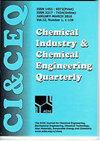不同电解液对ss316l微细电解加工的影响
IF 0.8
4区 工程技术
Q4 CHEMISTRY, APPLIED
Chemical Industry & Chemical Engineering Quarterly
Pub Date : 2022-01-01
DOI:10.2298/ciceq211204007v
引用次数: 0
摘要
不锈钢316L (SS 316L)在医疗、船舶、航空航天、生物医学和汽车等行业的使用正在迅速增加。电化学微加工(ECMM)具有加工表面无毛刺、无残余应力、加工精度高等优点,是加工不锈钢316L的理想方法。然而,在使用HCl、H2SO4、KOH、NaNO3、NaCl等强电解质方面存在一些局限性,据报道,这些强电解质在向环境中排放和处理方面存在困难。因此,为了克服ECMM工艺中使用强电解质加工SS 316L的缺点,本文考虑了酒石酸(C4H6O6)、柠檬酸(C6H8O7)等不同有机电解质,以及酒石酸和柠檬酸电解质的组合(混合电解质)来选择最佳电解质。加工电压、占空比、电解液浓度等工艺参数决定了加工性能。ECMM的性能是通过材料去除率(MRR)和超切来评估的。酒石酸电解质在12 g/l、11 V、85%的参数组合下,其过切量比混合电解质小179%。在25%、11 V、20 g/l的参数溶液下,混合电解质的MRR比酒石酸电解质高114.2%。此外,柠檬酸电解质在加工性能的各个方面都显示出第二低的过切和更高的MRR。通过场发射扫描电镜(FESEM)研究了电解液对加工表面的影响。本文章由计算机程序翻译,如有差异,请以英文原文为准。
Effect of different electrolytes on electrochemical micro-machining of SS 316L
The use of stainless steel 316L (SS 316L) in industries such as medical, marine, aerospace, bio-medical, and automobile sectors is increasing rapidly. Electrochemical micro-machining (ECMM) is the apt method for machining SS 316L due to its burr-free machining surface, no residual stress, and high precision. However, there are some limitations found in the usage of strong electrolytes such as HCl, H2SO4, KOH, NaNO3, and NaCl, which are reportedly facing difficulties in disposing it to the environment and handling issues. Hence, this paper addresses to overcome the disadvantages faced in ECMM process when using strong electrolytes to machine SS 316L, so therefore different organic electrolytes such as tartaric acid (C4H6O6), citric acid (C6H8O7), and a combination of tartaric and citric acid electrolyte (mixed electrolyte) are considered to select the best electrolyte. Process parameters like machining voltage, duty cycle, and electrolyte concentration are included in determining the performance of machining. The performance of ECMM is evaluated using material removal rate (MRR) and overcut. The overcut of tartaric acid electrolyte is found to be 179% less than mixed electrolyte for the parameter combination of 12 g/l, 11 V, and 85%. The mixed electrolyte shows 114.2% higher MRR than the tartaric acid electrolyte for the parameter solutions of 25%, 11 V, and 20 g/l. Furthermore, the citric acid electrolyte shows the second lowest overcut and higher MRR in all aspects of machining performance. Field emission scanning electron microscope (FESEM) studies are carried out to realise the effect of electrolyte on the machining surface.
求助全文
通过发布文献求助,成功后即可免费获取论文全文。
去求助
来源期刊

Chemical Industry & Chemical Engineering Quarterly
CHEMISTRY, APPLIED-ENGINEERING, CHEMICAL
CiteScore
2.10
自引率
0.00%
发文量
24
审稿时长
3.3 months
期刊介绍:
The Journal invites contributions to the following two main areas:
• Applied Chemistry dealing with the application of basic chemical sciences to industry
• Chemical Engineering dealing with the chemical and biochemical conversion of raw materials into different products as well as the design and operation of plants and equipment.
The Journal welcomes contributions focused on:
Chemical and Biochemical Engineering [...]
Process Systems Engineering[...]
Environmental Chemical and Process Engineering[...]
Materials Synthesis and Processing[...]
Food and Bioproducts Processing[...]
Process Technology[...]
 求助内容:
求助内容: 应助结果提醒方式:
应助结果提醒方式:


